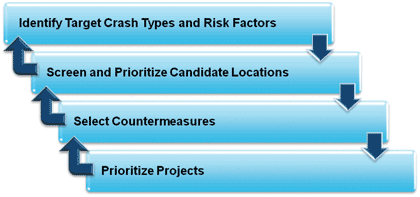A Systemic Approach to Safety
Using Risk to Drive Action
The systemic approach to safety involves improvements that are widely implemented based on high-risk roadway features correlated with particular severe crash types. As the figure on the right illustrates, 57 percent of fatal crashes occur on rural roads, which are often part of the local system. Because these crashes are not evenly distributed across the many miles of rural roadways, it is often difficult to isolate high-crash locations for safety improvements. The systemic approach answers the question:

Source: Cambridge Systematics, Inc.
Do all systems and crash types present equal opportunities for crash reduction, or do specific parts of the system and certain crash types offer a greater opportunity to save lives?
The Benefits of a Systemic Approach
Several agencies implementing systemic improvements have reported staggering results in crash reductions. The systemic approach:
Solves an Unmet Need in Transportation Safety
A significant number of severe crashes are spread out over a wide area, particularly on rural and local roadways, and for specific crash types such as those involving vulnerable road users. These crashes are rarely identified through the traditional site analysis approach because it is difficult to isolate high-crash locations. The systemic approach provides state, regional, and local agencies an alternative method to address these crash types and fulfill a previously unmet need.
Uses a Risk-Based Approach to Prevent Crashes
The systemic approach starts with a different premise for identifying safety problems, leading to a different set of projects. The systemic approach looks at crash history on an aggregate basis to identify high-risk roadway characteristics. While the traditional site analysis approach results in safety investments at high-crash locations, the systemic approach leads to widespread implementation of projects to reduce the potential for severe crashes.

Source: Cambridge Systematics, Inc.
Results in a Comprehensive Road Safety Program
The systemic approach does not replace the site analysis approach. It is a complementary technique intended to supplement site analysis and provide a more comprehensive and proactive approach to safety management efforts. Reducing crashes at individual locations clearly requires continued attention. At the same time, the systemic approach aims to reduce the risk of and the potential for the occurrence of future crashes.
Advances a Cost-Effective Means to Address Safety Concerns
The systemic approach considers multiple locations with similar risk characteristics. When examining the system as a whole, a particular roadway element may have a high-crash experience, and it is more cost-effective to correct the problem on a systemwide basis rather than by individual high-crash location.
How to Utilize the Systemic Approach
The systemic approach is iterative and intended to be flexible and easy to apply to a variety of systems, locations, and crash types. Similar to the site analysis approach and most common safety management processes, the systemic planning approach involves problem identification, countermeasure identification, and project prioritization.

Source: Cambridge Systematics, Inc.
Identify Target Crash Types/Risk Factors
Review systemwide data and location characteristics to focus on specific crash types and associated risk factors.
For example:
Crash Type – Roadway departure crashes on rural two-lane highways various roadway features.
Risk Factors – Average daily traffic volumes, curve density, access density.
Screen and Prioritize Candidate Locations
Use the risk factors to screen the network and prioritize candidate locations for safety investments that will reduce the potential for future severe crashes.
Select Countermeasures
Evaluate countermeasures such to select those that address roadway departures on roads with the identified risk factors.
For example:
Rumble strips, cable median barriers, or advanced curve delineation.
Prioritize Projects
Prioritize safety projects for implementation based on the risk-based assessment, available funding, other programmed projects, time to develop projects, and other considerations.
Forging Ahead
“The systemic approach has offered the State of Minnesota another opportunity to further improve safety on our roadways by proactively addressing at-risk elements not typically identified through traditional approaches. This has given us a way to fund and build safety projects in rural Minnesota, which in the past did not qualify for safety investments due to the lack of identified “high-crash” locations.”
– Sue Groth, State Traffic Engineer, MnDOT
Visit the Federal Highway Administration web site for additional information on the systemic approach to safety, including but not limited to the following:
- Overview Fact Sheet
- Systemic Safety Project Selection Tool
- Case Studies and Examples
- Narrated Presentation
- Training and Technical Assistance
